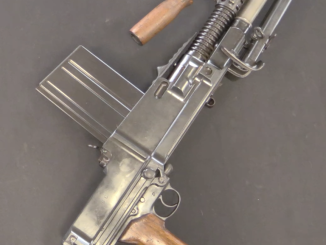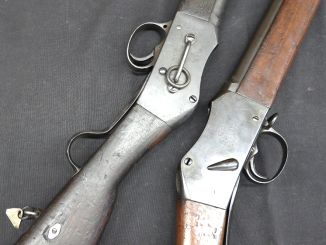The Orita SMG was designed by a Romanian Army Captian Marin Orita in 1941, and went into service in 1943. It was used primarily in Southern Europe in late WW2 with Romanian forces. It was a wood-stocked, simple blowback, 9x19mm weapon. As originally designed, the Model 1941 Orita was not drop-safe, and this was addressed in a 1948 upgrade program. That upgrade made a number of changes. It replaced the manual safety lever with a grip safety (which locked the bolt in place when not depressed, thus rendering the gun drop safe). It also replaced the one-piece wood stock with a strengthened metal wrist, and eliminated the semiauto selector lever.
The total known production is unknown (to me, at least), but virtually all of the 1941 patterns guns were updated to the 1948 standard. The Orita would serve in the Romanian Army until the 1950s, and in various reserve forces for several decades after.
Many thanks to the Royal Museum of the Armed Forces and Military History in Brussels for access to this very rare piece! Check them out here:
https://www.klm-mra.be/en/




“(…)designed by a Romanian Army Captian Marin Orita in 1941(…)”
https://www.vhu.cz/exhibit/rumunsky-samopal-orita-md-1941/ claims effective designers were Leopold Jašek (Czechoslavkia) and Nicolae Sterca (Romania). Above mentioned man was linked with production rather than development due to being boss of quality-control inside Copsa Mica si Cugir.
There is also an older page about the Orita right on this very site:
https://www.forgottenweapons.com/submachine-guns/orita-m1941/
Which also gives the same names as the principal designers (“Jeska” is probably a Romanian variant of “Jašek”). There is also an image of the elusive original model 1941 from a Romanian museum.
I meant “Jaska” not “Jeska”…
“(…)replaced the one-piece wood stock with a strengthened metal wrist(…)”
http://modernfirearms.net/en/submachine-guns/romania-submachine-guns/orita-m1941-eng/ claims that
…improved version of this weapon appeared in 1948, which was manufactured either with fixed wooden butt or with folding metallic butt…
photo of latter variant can be seen here https://smallarmsreview.com/romanian-9mm-orita-m1941-smg/ where it is described as Ultra rare Romanian 9mm Orita submachine gun with grip safety and folding metal stock..
Did it have own designation? What was its’ intended purpose? Does it predate 1948 variant or follow it timeline-wise?
you can find few of them in Czech and Slovak museums dedicated to the WW2 and Slovak Nationa Uprising. Romanian army /after they left Ax and joined Allied/ was helping with liberation of Czechoslovakia.
You mean handing it over to the Reds.There was no liberation.
I’m wondering if the two-part bolt design could work in a different way: given this is an open-bolt setup, at the moment the main body of the bolt is at the end of its forward travel and the primer is ignited, the “buffer” thingy is still travelling forward under inertia, compressing its spring and pressing against the bolt.
If timed correctly, the forward motion of the “buffer” could assist the bolt in fighting the blowback force and delaying the opening of the bolt, more than just by adding the “buffer” mass to the bolt mass by rigidly connecting them.
A similar effect to that obtained through advanced primer ignition without actually being API, since the bolt is stopped at that moment.
Obviously inspired by the German <P38/MP40, at least externally
I dont think it was inspired by it, maybe by long shot to mp41. All the rifle stocked smgs with thin no-handguard barrel look the same
Giving its’ designer I would point to CZ Vz. 38
http://modernfirearms.net/en/submachine-guns/czech-republic-submachine-guns/cz-vz-38-eng/
as possible inspiration
The Ț in Orița is pronounced like Ц or TS as in cats or perhaps like pizza.
This looks like something out of a Tintin comic.
I was in Romania in 1994 and went to a major museum in Bucharesti. They displayed behind glass many Orita weapons.
with all the scratches and dings on the stock, it looks like it had some hard use. I wish we could get a little more history of the individual gun…like how and where it was captured.
I know, that’s not something usually available or even recorded.